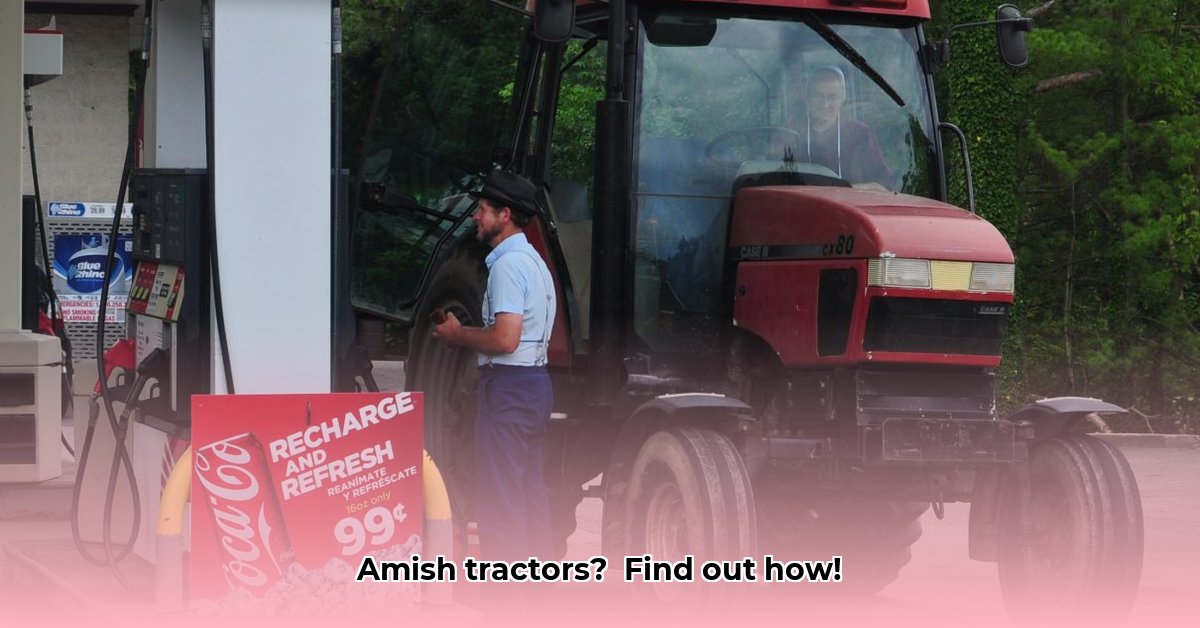
Can Amish Use Tractors? A Look at Amish Farming Practices
The Amish relationship with technology, particularly tractors, offers a compelling case study in the interplay between tradition and practical needs. While often associated with horse-drawn buggies, the reality of Amish farming is far more nuanced. The question of tractor usage isn't a simple yes or no; it's a complex issue shaped by deeply held beliefs, community practices, and regional variations. For more detailed information on Amish tractor use, see this resource.
The Tractor Question: More Than Just Machines
The Amish aren't uniformly opposed to technology; their choices reflect a core philosophy prioritizing community, self-reliance, and a close connection to the land. Many view gasoline-powered tractors as potentially disruptive to these values. The shared labor of traditional farming, using horses, fosters strong community bonds, considered essential to their way of life. It's less about the machine itself and more about its societal and environmental implications. How does mechanized farming affect their communal structure and their relationship with the land? This is a key question driving their decisions.
Did you know that the shared labor of horse-drawn farming strengthens community ties, a core value in Amish society? This contrasts sharply with the independent nature of mechanized farming.
A Diverse Group: Not a One-Size-Fits-All Answer
It's crucial to understand the diversity within Amish communities. Old Order and New Order groups, and even individual communities, hold varying views on technology adoption. Some may permit modified tractors—often featuring steel wheels to minimize environmental impact and maintain a traditional aesthetic—while others strictly adhere to horse-drawn methods. Geographical factors also play a role; hilly terrain might favor horse-drawn farming, while flat, fertile plains may lend themselves to tractor use. The type of farming practiced and established local customs significantly influence the technologies employed.
How does geography impact an Amish community's choice between horses and tractors? Consider the difference in terrain and the practical challenges of each method.
It's About More Than Just Tractors: A Holistic View
The Amish perspective reflects a holistic approach to farming and environmental stewardship. The common phrase, "They don't make manure," encapsulates their concern about disrupting natural processes. Traditional methods, they believe, promote healthier soil and a more sustainable agricultural cycle. This emphasis on sustainable practices and close interaction with the land is fundamental to their worldview.
What are the long-term environmental benefits of horse-drawn farming compared to even modified tractor use? Further research is needed to fully understand these impacts.
The Big Picture: What We Still Don't Know
While some studies point to potential drawbacks of tractor use, like soil compaction, a comprehensive understanding requires further investigation. The long-term environmental and economic consequences of both traditional and modified tractor farming warrant more detailed study. Research into the sustainability of each method is ongoing.
What are the long-term effects on soil health and agricultural yields of both traditional horse-powered and modified tractor farming? This is a critical area for future research.
Finding a Balance: Tradition and Progress
Reconciling Amish traditions with modern agricultural practices requires a multifaceted approach. Continued research exploring sustainable methods that align with Amish values is crucial. Open dialogue and mutual understanding are essential in navigating these complex issues. This entails respect for their cultural practices alongside a shared commitment to responsible environmental stewardship.
How can we support Amish communities in maintaining their traditions while also promoting environmentally responsible farming? This requires careful consideration and collaboration.
Amish Farming: A Comparison
| Farming Method | Advantages | Disadvantages | Considerations |
|---|---|---|---|
| Horse-Drawn Farming | Strong community bonds, traditional skills, sustainable practices | Labor-intensive, lower yield potential | Requires skilled labor, suitable land, weather preparedness |
| Modified Tractor Use | Increased efficiency, reduced labor, higher yield potential | Potential soil compaction, potential environmental concerns | Requires careful machine selection, maintenance, mindful operation |
The Amish approach to farming provides valuable insights into the complex relationship between tradition and progress. Their deliberate consideration of social, environmental, and spiritual impacts underscores the importance of thoughtful decision-making in agriculture. Their choices serve as a potent reminder of the often-conflicting forces at play in modern society. Further research will undoubtedly unveil additional insights into this fascinating subject.
How do Amish farmers mitigate soil compaction from modified tractor use?
The use of modified tractors reflects a pragmatic adaptation within some Amish communities, balancing tradition with the economic demands of modern farming. However, soil compaction remains a concern. Amish farmers, however, have implemented various strategies to mitigate this issue.
The Horse-Drawn Tradition and its Limits
The traditional reliance on horse-drawn equipment minimized soil compaction, offering a more gentle approach to land cultivation. However, the constraints of labor-intensive methods and the increasing economic pressures of modern agriculture necessitate exploration of alternative approaches within some communities.
How do Amish farmers balance their commitment to traditional practices with the need for increased efficiency in modern farming? This involves community discussions and careful consideration of various methods.
Mitigating Soil Compaction: Strategies Employed
Amish farmers use several strategies to minimize soil compaction from tractor use:
Reduced Tractor Use: Limiting tractor use to essential tasks, such as transporting harvested crops or preparing large fields.
Strategic Field Management: Dividing fields into smaller sections reduces continuous travel, minimizing compaction in any given area.
Crop Rotation: Implementing traditional crop rotation practices improves soil structure and resilience, counteracting compaction effects.
Cover Crops: Utilizing cover crops during fallow periods strengthens soil structure and reduces the risk of compaction.
No-Till/Minimal-Till Farming: Adopting these methods minimizes soil disturbance and preserves its natural structure.
Community Knowledge Sharing: Amish communities share best practices and experiences, fostering innovation in soil management to address the challenge of compaction.
The use of modified tractors within Amish communities showcases a careful balancing act between tradition and necessity. It's a testament to their adaptability and commitment to responsible land stewardship. These efforts highlight their ingenuity and commitment to sustainable farming practices within their unique community framework.